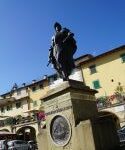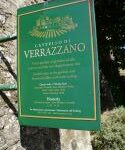August 21, 2017
Twenty-two million tourists visit Florence every year, and while they aren’t all here now, the presence of 22 million in a city of around half a million  certainly is obvious. It’s Florence’s biggest business (public restrooms are 1 euro—x million); the other is fashion. The Ferragamo family owns one of the biggest old palaces along the Arno, a no-longer navigable stream that cuts through the city. Gucci owns another.
certainly is obvious. It’s Florence’s biggest business (public restrooms are 1 euro—x million); the other is fashion. The Ferragamo family owns one of the biggest old palaces along the Arno, a no-longer navigable stream that cuts through the city. Gucci owns another.
The tourists have flocked here for centuries. Some have stayed. There’s an old English cemetery that contains the remains of Elizabeth Barrett Browning, for example. Famous guests at our 1903 hotel include two infamous 20th century leaders—il Duce and Hitler met here in 1938, plotting the Axis around which Europe would revolve. So, too, the Allied high command in World War II headquartered at the Baglioni.
There’s good reason for the tourist influx. Florence is a beautiful and historic city. The beauty came partly from Florence’s being the temporary capital of the united Italy in the 1860s, before the capture of Rome and the transfer there. In the meantime, Florence was “modernized,” which meant it had to look like Paris, with broad boulevards (mostly) sacrificed, and new buildings—neoclassical, primarily, erected to house the embassies of foreign countries.
The significant attractiveness of Florence came from the reemergence of Roman and Greek ideas that led to the Renaissance. The reemergence of Europe from the dark ages—can you say Galileo and Michelangelo?—began here. We’ll be seeing as much as we can of that today.
On the way here (it’s 30 direct miles from Siena, where Gothic prevailed  until its 16th century submission to Florence), we passed through the beautiful vineyards of Chianti, a province with a brand of wine (since 1924) that used to be in bottles with a straw base. With candles in the empty ones, they were a staple in the dorm rooms at the University of Chicago in the 1950s. Today the straw bases are so expensive those bottles are mostly for tourists.
until its 16th century submission to Florence), we passed through the beautiful vineyards of Chianti, a province with a brand of wine (since 1924) that used to be in bottles with a straw base. With candles in the empty ones, they were a staple in the dorm rooms at the University of Chicago in the 1950s. Today the straw bases are so expensive those bottles are mostly for tourists.
Chianti, though, is alive and well as a brand, the black rooster in the red seal, whose quality is enforced by inspectors at the variety of farms in the district.
We stopped at a small town, Greve in Chianti, for an introduction to the region, then went to one of the vineyards for a business visit. We learned that the good wines come from higher on the hill, table wines from lower down. Sugar is added to “priests’ wines,” a dessert wine that tastes rather like port.

 The castle/vineyard was the birthplace of Verrazzano, who left to explore the coast of North America (for the French. Florentine bankers financed his trip, and wanted it led by someone they knew). Verrazzano “discovered” New York’s harbor, and sailed from Nova Scotia to South America.
The castle/vineyard was the birthplace of Verrazzano, who left to explore the coast of North America (for the French. Florentine bankers financed his trip, and wanted it led by someone they knew). Verrazzano “discovered” New York’s harbor, and sailed from Nova Scotia to South America.
When the Verrazano Narrows bridge was built (he lost a z crossing the Atlantic), some stones from the castle were part of the bridge, while the castle acquired red, white and blue stones in return that are now prominently displayed.
Verrazzano, according to our guide, was part of the first Italian meal served in America. Stopping in the Bahamas, a hungry tribe had him for supper.
 We were luckier. We had wild boar salami, one of the delicacies of the district.
We were luckier. We had wild boar salami, one of the delicacies of the district.
Now to be one of the 22 million.